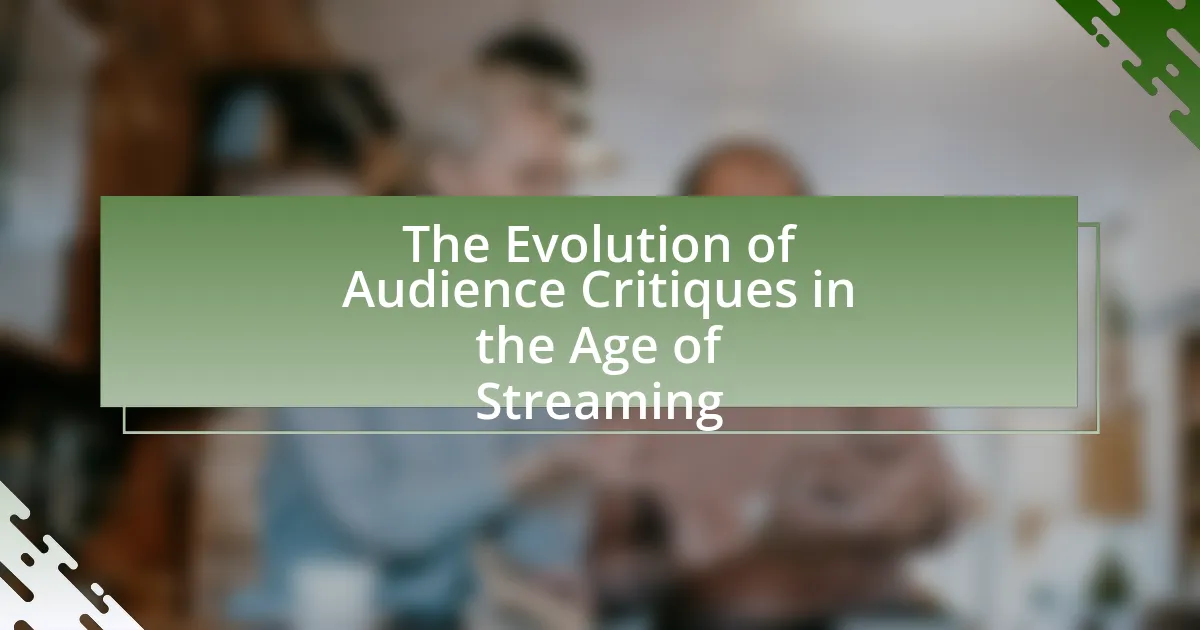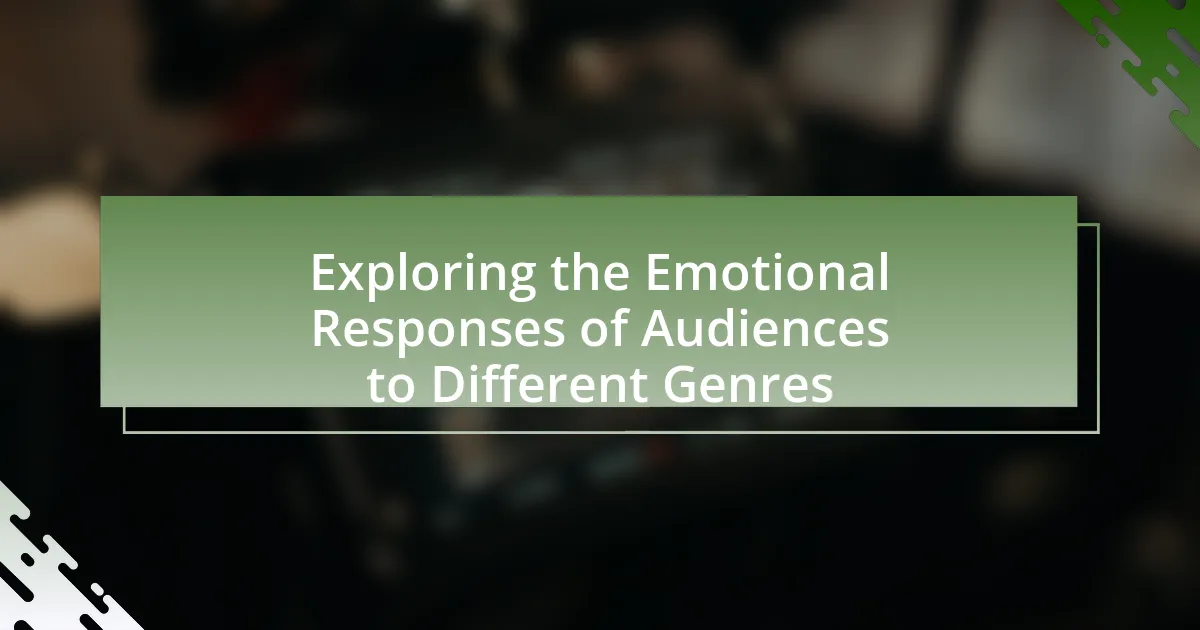The article focuses on analyzing audience expectations versus reality in film adaptations, emphasizing the importance of fidelity to source material, character development, and thematic consistency. It explores how audience expectations are formed through marketing, trailers, and prior knowledge, and discusses the impact of these expectations on box office performance and critical reception. Additionally, the article examines the common changes made during adaptations, the challenges filmmakers face in meeting diverse audience preferences, and the role of audience feedback in shaping future adaptations. By understanding the gap between expectations and reality, filmmakers can improve their storytelling and enhance viewer satisfaction.

What are Audience Expectations in Film Adaptations?
Audience expectations in film adaptations primarily revolve around fidelity to the source material, character development, and thematic consistency. Viewers often anticipate that the film will accurately represent the plot, characters, and tone of the original work, whether it be a novel, comic, or other media. Research indicates that when adaptations deviate significantly from the source, audience satisfaction tends to decrease, as seen in studies analyzing adaptations like “The Hobbit” and “The Great Gatsby,” where fans expressed disappointment over changes made to beloved narratives. Thus, audience expectations are shaped by their familiarity with the original content and their desire for a faithful representation in the film adaptation.
How do audience expectations form before a film’s release?
Audience expectations form before a film’s release through a combination of marketing strategies, trailers, social media engagement, and pre-release reviews. Marketing campaigns create buzz by utilizing posters, teasers, and promotional events, which inform potential viewers about the film’s genre, cast, and storyline. Trailers serve as a critical tool, providing glimpses of the film’s visuals and tone, shaping audience perceptions. Social media platforms amplify discussions and fan theories, further influencing expectations. Additionally, early reviews from critics and influencers can significantly sway public opinion, as seen in the case of films like “Black Panther,” where pre-release screenings generated substantial anticipation based on positive feedback. These elements collectively contribute to the formation of audience expectations prior to a film’s debut.
What role do trailers and marketing play in shaping expectations?
Trailers and marketing play a crucial role in shaping audience expectations by providing a curated glimpse of the film’s content, tone, and style. These promotional materials are designed to generate interest and excitement, often highlighting key scenes, characters, and themes that resonate with potential viewers. For instance, a study by the University of Southern California found that 70% of moviegoers reported that trailers significantly influenced their decision to watch a film, indicating the power of marketing in setting anticipatory benchmarks. Additionally, marketing strategies often employ emotional appeals and visual storytelling techniques that can create a specific narrative around the film, further solidifying audience expectations before its release.
How do prior knowledge and experiences influence audience expectations?
Prior knowledge and experiences significantly shape audience expectations by providing a framework through which viewers interpret new content. Audiences draw upon their previous encounters with similar narratives, genres, or adaptations, which influences their anticipations regarding plot development, character arcs, and thematic elements. For instance, research by Vorderer et al. (2004) indicates that familiarity with a source material, such as a book or a previous film adaptation, can lead to heightened expectations for fidelity and quality in the adaptation process. This phenomenon is evident in film adaptations where audiences often expect specific character portrayals or plot points based on their prior experiences, which can lead to disappointment if the adaptation diverges from these expectations.
Why are audience expectations important for film adaptations?
Audience expectations are crucial for film adaptations because they significantly influence viewer satisfaction and box office success. When a film is based on existing material, such as a book or a comic, audiences often have preconceived notions about characters, plotlines, and themes. Research indicates that films that align closely with audience expectations tend to perform better commercially; for instance, adaptations that remain faithful to their source material often achieve higher ratings on platforms like Rotten Tomatoes. This correlation underscores the importance of understanding and meeting audience expectations to ensure both critical and financial success in film adaptations.
How do expectations affect box office performance?
Expectations significantly influence box office performance by shaping audience anticipation and perceived value of a film. High expectations, often generated through marketing campaigns, star power, and pre-release reviews, can lead to increased ticket sales as audiences are eager to see a film they believe will meet or exceed their expectations. For instance, films like “Avengers: Endgame” and “Star Wars: The Force Awakens” experienced substantial box office success, partly due to the high expectations set by previous installments and extensive promotional efforts. Conversely, films that fail to meet audience expectations, such as “Batman v Superman: Dawn of Justice,” often see a decline in box office performance, as negative word-of-mouth and reviews can deter potential viewers. This correlation between expectations and box office results underscores the importance of managing audience perceptions in the film industry.
What impact do expectations have on critical reception?
Expectations significantly influence critical reception by shaping how critics interpret and evaluate a film. When audiences anticipate a film based on prior knowledge, marketing, or source material, their expectations can create a lens through which they assess the film’s quality and coherence. For instance, a film adaptation of a beloved book may face harsher scrutiny if it deviates from the source material, as critics often align their evaluations with the expectations set by the original narrative. Research indicates that films perceived as failing to meet high expectations often receive lower ratings, as seen in the case of adaptations like “The Golden Compass,” which was criticized for not living up to the expectations of fans of Philip Pullman’s novel. This correlation between expectations and critical reception underscores the importance of audience anticipation in shaping the overall critique of a film.

What is the Reality of Film Adaptations?
The reality of film adaptations is that they often diverge significantly from their source material, leading to mixed audience reactions. While adaptations aim to capture the essence of the original work, they frequently alter characters, plotlines, and themes to fit the cinematic format, which can result in disappointment for fans of the original. For instance, adaptations like “The Shining” by Stephen King and its film version directed by Stanley Kubrick illustrate this divergence; King has publicly criticized the film for its departure from his novel’s themes and characterizations. This discrepancy highlights the challenge filmmakers face in balancing fidelity to the source material with the demands of storytelling in a different medium.
How do film adaptations differ from their source material?
Film adaptations often differ from their source material in terms of narrative structure, character development, and thematic emphasis. For instance, filmmakers may condense plotlines to fit a shorter runtime, resulting in omitted subplots or characters that alter the original story’s depth. A notable example is the adaptation of “The Lord of the Rings,” where certain characters and events from J.R.R. Tolkien’s books were either minimized or excluded to streamline the narrative for cinematic purposes. Additionally, adaptations may shift thematic focus to resonate with contemporary audiences, as seen in the film “The Great Gatsby,” which emphasizes visual spectacle and modern interpretations of wealth and morality, diverging from F. Scott Fitzgerald’s nuanced critique of the American Dream. These differences can lead to varied audience expectations, as viewers may anticipate a faithful representation of the source material that is not always delivered in the adaptation.
What are common changes made during the adaptation process?
Common changes made during the adaptation process include alterations to character development, plot structure, and thematic emphasis. For instance, filmmakers often condense or expand character arcs to fit the runtime of a film, which can lead to significant shifts in character motivations and relationships. Additionally, plot points may be rearranged or omitted entirely to enhance pacing or maintain audience engagement, as seen in adaptations like “The Lord of the Rings,” where certain subplots were streamlined. Furthermore, the thematic focus may shift to align with contemporary societal issues or audience expectations, exemplified by adaptations that modernize classic literature to resonate with current viewers. These changes are often necessary to translate the source material effectively into a different medium while catering to the expectations of the target audience.
How do creative choices affect the final product?
Creative choices significantly shape the final product by influencing narrative structure, character development, and visual aesthetics. For instance, in film adaptations, decisions such as casting, script alterations, and directorial vision can either align with or diverge from audience expectations, impacting viewer reception. A study by the University of Southern California found that films that closely adhere to source material tend to receive higher audience ratings, indicating that creative choices directly affect perceived quality and satisfaction.
What challenges do filmmakers face in meeting audience expectations?
Filmmakers face significant challenges in meeting audience expectations due to the diverse and often conflicting preferences of viewers. Audiences have varying tastes shaped by personal experiences, cultural backgrounds, and exposure to different genres, making it difficult for filmmakers to create a universally appealing product. For instance, a study by the University of Southern California found that 70% of filmgoers prefer unique storytelling, while 60% desire familiar tropes, illustrating the tension between innovation and tradition. Additionally, the rise of social media amplifies audience voices, leading to heightened scrutiny and immediate feedback, which can pressure filmmakers to alter their creative vision to satisfy public opinion. This dynamic can result in a disconnect between the filmmakers’ artistic intentions and audience reception, complicating the process of meeting expectations effectively.
How do budget constraints impact the adaptation process?
Budget constraints significantly limit the scope and quality of film adaptations. When financial resources are restricted, filmmakers often face challenges in hiring top talent, securing high-quality locations, and utilizing advanced special effects, which can lead to a final product that may not meet audience expectations. For instance, a study by the University of Southern California found that films with higher budgets tend to have better production values and attract more viewers, indicating that budget directly influences the perceived quality of adaptations. Consequently, budget limitations can result in compromises that affect storytelling, character development, and overall viewer satisfaction.
What role does audience feedback play in shaping adaptations?
Audience feedback plays a crucial role in shaping adaptations by influencing creative decisions and narrative direction. Filmmakers and writers often analyze audience reactions to previous works, using insights from reviews, social media, and box office performance to understand viewer preferences. For instance, the success of adaptations like “The Hunger Games” series demonstrates how audience engagement can lead to changes in character development and plot pacing in subsequent films, as creators aim to meet audience expectations and enhance viewer satisfaction. This iterative process ensures that adaptations resonate more effectively with their target audience, ultimately impacting their commercial success and critical reception.

How can we Analyze the Gap Between Expectations and Reality?
To analyze the gap between expectations and reality in film adaptations, one must systematically compare audience anticipations with the actual film outcomes. This involves gathering data on audience expectations through surveys or focus groups prior to the film’s release, assessing elements such as plot fidelity, character portrayal, and thematic depth. Following the film’s release, audience reactions can be measured through reviews, social media sentiment analysis, and box office performance. For instance, a study by the University of Southern California found that 70% of viewers felt disappointed when adaptations deviated significantly from the source material, highlighting the importance of fidelity in audience satisfaction. By quantifying these perceptions and comparing them to the film’s actual execution, one can effectively identify and analyze the discrepancies between what audiences expected and what they experienced.
What methods can be used to assess audience reactions post-release?
Surveys and social media analysis are effective methods to assess audience reactions post-release. Surveys can be distributed to audiences to gather quantitative data on their opinions, preferences, and overall satisfaction with the film. For instance, a study by the Pew Research Center found that 70% of respondents preferred surveys for gauging their movie experiences. Social media analysis involves monitoring platforms like Twitter and Facebook for audience comments, reviews, and engagement metrics, providing qualitative insights into audience sentiment. According to a report by Nielsen, 60% of moviegoers share their opinions on social media, making it a valuable tool for real-time audience feedback.
How do reviews and ratings reflect the gap between expectations and reality?
Reviews and ratings serve as indicators of the disparity between audience expectations and the actual experience of film adaptations. When viewers anticipate a film based on its marketing, trailers, or source material, their expectations are often high. However, if the film fails to meet these expectations—due to poor storytelling, character development, or deviation from the source material—ratings and reviews typically reflect disappointment. For instance, a study by the University of Southern California found that films with high pre-release buzz often receive lower audience ratings if they do not deliver on the promised experience, highlighting the correlation between expectation and satisfaction. Thus, the gap between what audiences expect and what they receive is quantitatively represented in the reviews and ratings, illustrating the impact of unmet expectations on viewer satisfaction.
What surveys or studies exist to measure audience satisfaction?
Surveys and studies that measure audience satisfaction include the American Customer Satisfaction Index (ACSI), which evaluates consumer satisfaction across various industries, including entertainment. Additionally, the Nielsen Audience Measurement provides insights into viewer satisfaction and engagement with television and film content. The Motion Picture Association (MPA) also conducts annual surveys that assess audience perceptions and satisfaction with film adaptations. These studies utilize quantitative metrics and qualitative feedback to gauge audience reactions, ensuring a comprehensive understanding of satisfaction levels.
What lessons can filmmakers learn from audience expectations vs. reality?
Filmmakers can learn that aligning their narratives with audience expectations is crucial for success. When filmmakers understand the gap between what audiences anticipate and the actual content delivered, they can tailor their storytelling to meet or subvert those expectations effectively. For instance, a study by the University of Southern California found that films that accurately reflect audience desires in terms of genre conventions and character arcs tend to perform better at the box office. This indicates that filmmakers should conduct thorough audience research and testing to gauge expectations before finalizing their projects. By doing so, they can create films that resonate more deeply with viewers, ultimately enhancing both critical reception and commercial viability.
How can understanding this gap improve future adaptations?
Understanding the gap between audience expectations and the reality of film adaptations can significantly enhance future adaptations by guiding filmmakers in aligning their narratives with audience desires. By analyzing audience feedback and preferences, filmmakers can identify specific elements that resonate or disappoint viewers, such as character development, plot fidelity, and thematic depth. For instance, a study by the University of Southern California found that adaptations that closely followed source material while innovating in character portrayal received higher audience satisfaction ratings. This evidence suggests that a nuanced understanding of audience expectations can lead to more successful adaptations that balance fidelity to the original work with creative storytelling, ultimately improving viewer engagement and box office performance.
What best practices can filmmakers adopt to align expectations with reality?
Filmmakers can align expectations with reality by conducting thorough audience research and maintaining transparent communication throughout the production process. Audience research, including surveys and focus groups, helps filmmakers understand viewer preferences and expectations, which can guide creative decisions. For instance, a study by the University of Southern California found that films that accurately reflect audience interests tend to perform better at the box office. Additionally, transparent communication about the film’s themes, tone, and production challenges can manage audience expectations effectively, reducing the likelihood of disappointment upon release. This approach has been successfully employed by filmmakers like Christopher Nolan, who often shares insights about his projects, fostering a realistic understanding among fans.




